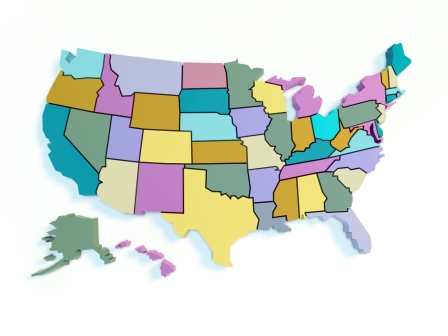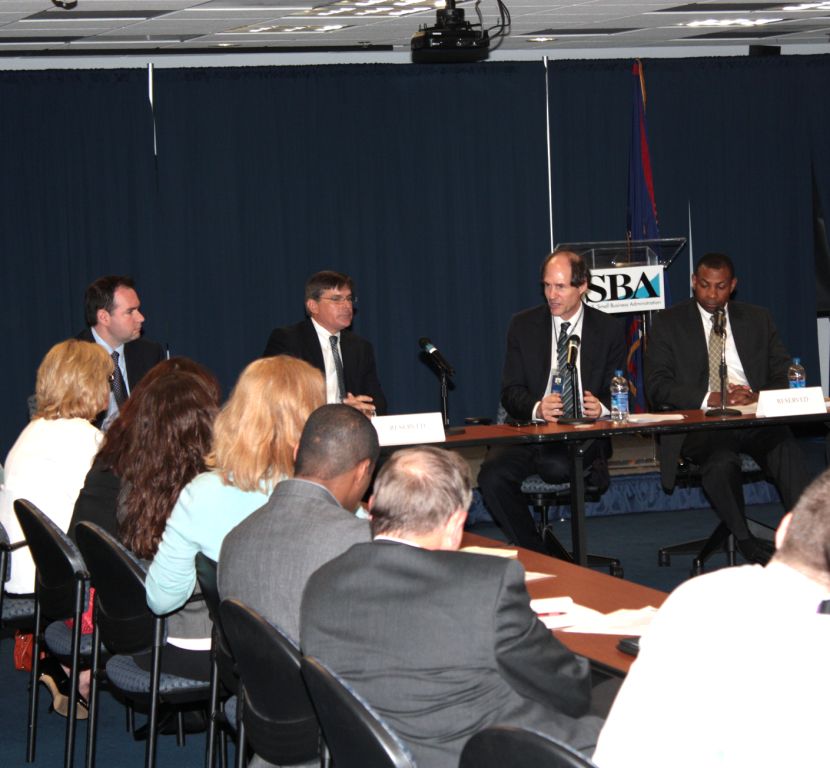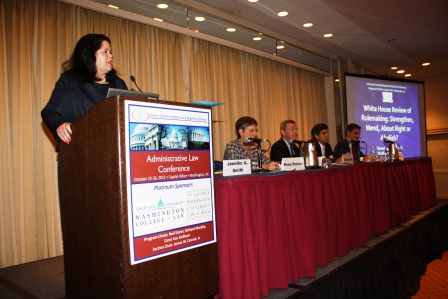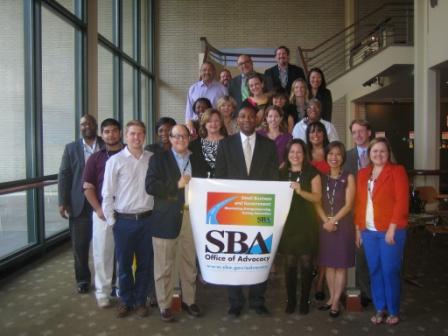
How are small businesses doing in your state? The Office of Advocacy has just published the Small Business Profiles for the States and Territories, to help answer this question. These profiles are brief two-page documents that give policymakers, small business owners, economists, and many others a detailed picture of the economic role of small businesses within their state, or the nation as a whole. They are also a useful tool to track changes and trends in each state’s small business economy.
The profiles offer a glimpse of the small business status in each state, territory, and the nation. The five states with the largest populations—California, Texas, New York, Florida and Illinois—account for roughly 38 percent of the total number of small employers in the country. However, the highest shares of small firm employment are found in the less populous states, the top five being Montana, with 68.4 percent of its jobs provided by small businesses; Wyoming (64.8 percent); South Dakota and North Dakota (tied at 61.9 percent); and Vermont (59.7 percent). From a finance perspective, the average number of business loans under $100,000 for the five largest states was 238,967, with a mean total value of $4.3 million.
Each individual profile contains information pertaining to the growth and decline of that region’s small business economy, comparing the most recent data available with prior years’ data. The information included in the state and U.S. profiles include total number of businesses, both small and large, business owner demographics, workforce breakdown, unemployment rate, lending, revenues, employment and employer firms by industry, net new jobs created, and establishment turnover rates. Please note that only limited data are available for the four U.S. territories.
The Office of Advocacy releases this information with the most recent available data at the time of publication, utilizing data from the U.S. Department of Commerce, Census Bureau and Bureau of Economic Analysis; U.S. Department of Labor, Bureau of Labor Statistics; Administration Office of the U.S. Courts; Federal Deposit Insurance Corporation; and the Small Business Administration, Office of Advocacy. Each profile is available in PDF format on the website, along with the raw data files.
—Shawn Fouladi, Research Assistant
Tags: Research & Statistics · State and Regional

On January 25, a coalition of competitive telecommunications carriers filed a petition with the Federal Communications Commission (FCC) requesting that the FCC propose new regulations governing the retirement of copper communications infrastructure owned by incumbent carriers. (The incumbents are the group of large telcos which resulted from the breakup of the Bell operating companies in the 1980s.) In many cases, small business consumers rely on the broadband services provided by carriers over these copper facilities, and the speed at which retirement is proceeding jeopardizes these services. Advocacy has previously submitted several public comments to the FCC forwarding the concerns of competitive carriers with regard to the effectiveness of its copper retirement regulations. The FCC is now asking the public to submit comments regarding this latest petition.
The Telecommunications Act of 1996 requires incumbent carriers to lease access to elements of the national telephone network to competing providers at wholesale rates, so that competitors can offer consumers a choice in communications providers without a need to duplicate the copper network. In 2003, the FCC determined that these wholesale obligations apply only to the copper network, and not to fiber optic connections. As incumbent carriers move toward building fiber optic connections, they are permitted to disable their existing copper connections; however, FCC regulations govern their retirement of these copper connections, in order to protect consumer choice.
Competitive carriers have requested the FCC revisit these regulations in several instances, arguing that the copper infrastructure should not be able to be retired by incumbents as a means to avoid the requirements of the 1996 Telecommunications Act. In the January 25 petition, the competitive carriers stress that preserving their ability to offer Ethernet broadband over the copper network is essential to making high-speed broadband service affordable and widespread, as the law requires. They suggest several changes to the FCC’s current copper retirement regulations. Notably, they request that the rules be revised to prohibit the physical removal or disabling of copper facilities unless the FCC confirms that customers will continue to have a choice among reasonably priced, similar services and will not have service disrupted.
The first round of public comments on the petition is due March 5 with the second round of reply comments due March 20. Comments may be submitted electronically by accessing the FCC’s Electronic Comment Filing System. Comments should reference and be submitted under WC Docket No. 12-353 and RM-11358.
—Assistant Chief Counsel Jamie Saloom
Previous Advocacy Comments on Copper Retirement
The Office of Advocacy has filed comments referencing copper retirement three times since 2007:
Tags: Regulatory Policy
On Friday, January 25, Jordan Barab, the U.S. Department of Labor’s deputy assistant secretary for occupational safety and health, participated in the Office of Advocacy’s regular small business roundtable on labor safety and health issues. Mr. Barab focused his remarks on the Occupational Safety and Health Administration’s (OSHA’s) regulatory agenda for the coming year and beyond. Mr. Barab also announced that he would be staying on at OSHA for President Obama’s second term, along with other key OSHA leaders, including Assistant Secretary David Michaels and Chief of Staff Deborah Berkowitz.
Mr. Barab laid out an ambitious agenda for the coming year which includes three Small Business Advocacy Review panels. The panels will allow small business representatives to provide input to agency officials before the rule is developed. The topics of the three panels will be Injury and Illness Prevention Plans (I2P2), Infectious Diseases, and Combustible Dust. He also stated that OSHA planned to publish its proposed rule on Occupational Exposure to Crystalline Silica, which has been pending under review at the Office of Management and Budget for nearly two years. Mr. Barab fielded a host of questions from attendees on such topics as OSHA enforcement policy, workplace injury and illness rates, and implementation of OSHA’s new rules on hazard communication. It was a collegial and wide-ranging discussion.
Advocacy’s roundtable was well-attended, with nearly 100 participants from across a variety of sectors. The roundtable meets every other month and focuses on regulatory activity by OSHA, the Mine Safety and Health Administration (MSHA), and other agencies. If you would like to attend or be added to the email distribution list, please contact Assistant Chief Counsel Bruce Lundegren.

Advocacy January 25 roundtable on labor safety and health issues. Photo by Kyle W. Kempf.
Tags: Regulatory Policy
January 24th, 2013 · Comments Off
In December, Region VII Advocate Becky Greenwald was a special guest speaker at the Women in Business Small Business Conference and Expo. The event was sponsored by the Nebraska Business Development Center/Procurement Technical Assistance Center at the University of Nebraska at Omaha. Hosting the event was Nebraska Congressman Lee Terry, who recognized 12 women business owners making a difference in his district (pictured below).

Click on the photo to jump to Congressman Terry’s speech recognizing each of these business owners in the Federal Register on December 18, 2012.
Front row, from left: Connie Martin, SpecPro; Danielle Zoz, GovDirect, represented by Paige Zoz; Tracie Malesa, Du-Rite Electric; Nancy Sempek, Christensen Drywall.
Middle row: Lee Pankowski, LP Custodial Services; Tina Diaz-Ciechomski, Future Construction Specialties; Jennifer Maassen, McCallie Associates.
Back row: BC Clark, Metro Omaha Women’s Business Center; Diane Bruce, Charv’s Contracting; Felicia Rogers, Congressman Lee Terry’s Office; Shayne Fili, Auction Solutions; and Lisa Wolford, CSSS.net, represented by an employee.
Not pictured: Julie Kaup, Boss Electric.
Tags: State and Regional
January 16th, 2013 · Comments Off
The Office of Advocacy applauds yesterday’s decision by the Internal Revenue Service to offer a simplified version of the home office deduction. Advocacy has been engaged with the small business community and the IRS on this issue for decades, including a formal request to the White House in 2009. The new option allows a deduction of up to $1,500 based on a formula of $5 per square foot of home office spaced used and will take effect for the 2013 tax year. The IRS estimates that this change in the rule will reduce the paperwork burden on small businesses by 1.6 million hours annually. An estimated 14.4 million, or 52 percent of America’s 27.8 million small businesses, are home based.
“Simplifying the home office deduction for America’s small businesses has been a longstanding priority of the Office of Advocacy; we welcome the IRS’s actions,” said Chief Counsel for Advocacy Winslow Sargeant. “I would also like to commend the steadfast advocacy of numerous small business organizations who have championed this issue.”
Over the years, Advocacy has worked with the IRS to encourage the simplification of the home office business deduction. In 2009, Advocacy sent a letter to the Presidential Economic Recovery Advisory Board’s Tax Reform Subcommittee, identifying the simplification of the home office business deduction as its top recommendation and suggesting that the IRS offer a standard deduction option. Advocacy will continue to pursue straightforward solutions for small business through tax reform.
Tags: Regulatory Policy
January 9th, 2013 · Comments Off
The deadline for submitting proposals for small business research for the Office of Advocacy has been extended to February 8. The original announcement with the revised deadline follows.
The Office of Advocacy examines the role of small business in the economy and publishes research on a wide range of topics each year. These studies educate policymakers and small business advocates, and they expand knowledge of small business challenges and contributions. Advocacy recently issued a Request for Quotations (RFQ) seeking proposals for new research in four areas. To view the complete solicitations, visit FedBizOpps and search for the solicitation numbers next to each topic. Research is to be conducted in the year following the contract award. These RFQs are for competitive contracts and are not research grants. The deadline for submitting proposals is Friday, February 8, at 4 p.m. Eastern standard time.
|
Office of Advocacy Research Proposal Topics, January 2013
|
| • Small Business Access to Capital Using Data Sets |
(SBAHQ-13-Q-0003)
|
| This research should use alternative (non-government) data sources to look at the supply and demand sides of the small business lending market to assess small businesses’ loan demand, their use of capital, and the real economic impact (such as job creation) of small business capital investments. |
| • Data Gaps in Measuring Small Business Dynamics |
(SBAHQ-13-Q-0004)
|
| This research should focus on data gaps that prevent policymakers, academics and entrepreneurs from actively measuring the dynamics of small businesses with respect to job creation, access to capital, demographics, and innovation. |
| • Entrepreneurship in an Aging America |
(SBAHQ-13-Q-0005)
|
| As the boomer generation ages, the percentage launching second careers as entrepreneurs has fallen slightly. This research should produce recommendations that policymakers can use in determining how to support older workers making the transition from wage work to business ownership. |
| • Support for Small Manufacturers |
(SBAHQ-13-Q-0006)
|
| This research should analyze initiatives in support of small manufacturers across selected coordinated economies in Europe and Asia (e.g., Germany, Japan, China, and South Korea). The study may examine small business scale-up, exporting, workforce training, national security needs and other areas. |
| The deadline for submitting proposals is Friday, February 8, at 4 p.m. Eastern standard time. |
The Office of Advocacy of the U.S. Small Business Administration is an independent voice for small business within the federal government. The presidentially appointed and Senate-confirmed Chief Counsel for Advocacy advances the views, concerns, and interests of small business before Congress, the White House and federal agencies. To learn more about Advocacy, visit our website or call (202) 205-6533, and follow us on Twitter and Facebook.
Tags: Research & Statistics
January 7th, 2013 · Comments Off
On December 28, the Internal Revenue Service (IRS) issued proposed regulations that that provide guidance on large employers’ shared responsibility for employee health insurance coverage under Internal Revenue Code section 4980H. The proposed regulations provide definitions and rules for determining status as an applicable large employer and applicable large employer member, for determining full-time employees, for determining assessable payments under section 4980H(a), for determining whether an employer is subject to assessable payments under section 4980H(b), and for administering and assessing payments under section 4980H.
Comments are due by March 18, 2013.
- The proposed regulations are on the IRS website.
- Comments on the final rule can be submitted to the IRS electronically via Regulations.gov (REG-138006-12).
- The Office of Advocacy contact is Assistant Chief Counsel Dillon Taylor, phone (202) 401-9787.
- To learn more, visit Regulations.gov, the federal government’s one stop site to comment on federal regulations.
- For more information on Regulatory Alerts please see the Office of Advocacy webpage.
- Visit the SBA subscription page to receive Regulatory Alerts in your in box.

Tags: Regulatory Policy
January 4th, 2013 · Comments Off
In 2012, the Office of Advocacy provided input to numerous federal agencies on key regulatory proposals that have a disproportionate impact on small businesses. The Patent and Trademark Office’s overhaul of the U.S. patenting system is one of these critical areas. All comment letters and fact sheets summarizing them are available on Advocacy’s website.
The U.S. Patent and Trademark Office (PTO) is continuing to move forward in implementing the Leahy-Smith America Invents Act (AIA), and is reviewing the public comments it has received regarding its proposed rules and examination guidelines concerning the “first-inventor-to-file” (FITF) provisions of the AIA. The majority of comments PTO received focus on the controversial issue of the PTO’s interpretation of the AIA’s grace-period provisions, which allow inventors and third parties to make certain public disclosures regarding an invention before filing a patent application, without jeopardizing the filer’s ability to receive a patent at a later date.
On October 4, Advocacy filed public comments on the proposals after conducting outreach with small entities, including nonprofit research and educational institutions. These stakeholders expressed strong concerns that PTO’s interpretation is inconsistent with congressional intent and would have chilling effects on innovation in the academic setting, as well as within the startup community. Advocacy urged the PTO to consider alternative interpretations of the law.
The draft final regulations are currently being reviewed by Office of Information and Regulatory Affairs of the White House Office of Management and Budget; they will take effect March 16, 2013. Interested stakeholders should contact Assistant Chief Counsel Jamie Belcore.
—Assistant Chief Counsel Jamie Belcore

Tags: Regulatory Policy
January 3rd, 2013 · Comments Off
In 2012, Advocacy commented on three key revisions of the Real Estate Settlement Procedures Act (RESPA or Regulation X) and the Truth in Lending Act (TILA or Reg Z):
• The integrated mortgage disclosure statement (comments filed November 6)
• Mortgage servicing rules for ARMs (October 5), and
• Loan originator compensation (October 16).
Mortgage Disclosure Statements. This major rule governs the practices and documents in use when consumers close on real estate loans. Although the proposal makes several changes to RESPA/TILA, the top five issues for small entities concern the costs from the expanded recordkeeping requirements, the difficulties of integrating the two mortgage disclosure statements used under the previous system, problems arising from the revised definition of the term “loan application,” the burden of requiring three days for the presumed receipt of documents, and confusion arising from defining Saturday as a business day.
To alleviate their impact on small business while maintaining the rule’s purpose, Advocacy recommended that CFPB allow for flexibility in small business compliance with the regulation, delaying the effective date of one measure, providing an exemption from another, and specific modifications of others.
Mortgage Servicing. The proposed rule would require periodic statements for residential mortgages, a six-month notification prior to the reset of the initial rate of hybrid Adjustable Rate Mortgages (ARMs), and the possible extension of this requirement to other ARMs. Small entities have said that these changes would be costly for them. Small mortgage servicers use a different business model that is relationship-based and customer service-friendly. As such, they argue that they were not the cause of some of the problems that the statute was meant to address. Advocacy encouraged the CFPB to exempt small entities from many of the requirements of the proposal. For the aspects of the proposal that do not exempt small entities, Advocacy encouraged the CFPB to provide small entities with a sufficient amount of time for them to comply with the requirements of this proposal.
Mortgage Loan Originator Compensation. The proposal would implement statutory changes to Regulation Z’s current loan originator compensation provisions, including a new restriction on the imposition of any upfront discount points, origination points, or fees on consumers under certain circumstances. Advocacy encouraged the CFPB to clarify aspects of the proposal, to fully consider small entities’ concerns, and to carefully consider the alternatives that have been set forth by the industry. Advocacy also encouraged the CFPB to develop revenue limits that reflect the unique business structure of smaller industry members and provide relief to small entities.
The comment letters and fact sheets summarizing them are available on Advocacy’s website.
—Assistant Chief Counsel Jennifer Smith
Tags: Regulatory Policy
December 21st, 2012 · 3 Comments
As 2012 winds down, the Office of Advocacy continues to build up an impressive number of achievements working with federal agencies and small business owners to bring transparency to the regulatory process. The synergy between our research and regulatory work continues to strengthen both areas; timely and actionable research is the foundation of efficient and sound regulation.
In 2012, Advocacy was pleased to see the introduction of Executive Order 13610, Identifying and Reducing Regulatory Burdens. This built on Executive Orders 13563 and 13609, supporting a structural reporting requirement for regulatory reform and review.
During 2012 we saw the exit of OIRA Administrator Cass Sunstein. Before departing Sunstein made clear the need to assess the cumulative impact of regulation, which was part of a wider recognition of the need to assess the regulatory cost-benefit calculus.

This affirmation is particularly relevant as several key statutes will require agencies to issue new implementing regulations. Among these are:
• The Affordable Care Act, with new regulatory proposals issued or forthcoming from the Departments of Health and Human Services (Centers for Medicare and Medicaid Services), Labor, and Treasury (Internal Revenue Service);
• The America Invents Act, which set in motion the Patent and Trademark Office’s overhaul of the patent process, including implementation of the “first-inventor-to-file” patent provision; and
• The Dodd-Frank Act, which created the Consumer Financial Protection Bureau and added small business review panels to the agency for rulemakings expected to have a significant impact on a substantial number of small entities. So far, four panels have been convened as part of the agency’s overhaul of consumer lending practices. Advocacy has been a partner on all of these panels.
The widening recognition of Advocacy’s key role was apparent in November, during the American Bar Association’s administrative law conference in Washington. Advocacy staff were facilitators and panelists at four well-attended sessions.

Advocacy understands the role that statistics play in supporting the small business community. This year we updated our most widely used publication, “Frequently Asked Questions about Small Business.” We added informative graphics and doubled the amount of data from previous editions to make it even more helpful. Our Office of Economic Research has replaced its annual small business data set with quarterly data bulletins, again to improve accessibility and timeliness of information.
As part of the recognition that no “one size fits all” small businesses, Advocacy launched our Innovation Initiative. The Innovation Initiative is designed to shed light on concerns and challenges faced by emerging sectors of our economy, among them, key sectors in life sciences, clean energy, advanced manufacturing, nanomaterials, and data mining (big data).
In September, we held a one-day event in Seattle, Washington, highlighting the ways that the public and private sectors can work together in support of innovative small businesses. To better understand the needs of this high-growth sector, Advocacy staff also participated in events held by other organizations which focused on innovation and entrepreneurship. Many issues that disproportionately affect innovative businesses were discussed. Some examples include visas and immigration issues; intellectual property and patents; early stage financing options (crowd funding, micro-finance, venture capital, angel investment); the SBIR/STTR programs; specific licensing procedures, e.g., FDA 510(k); and specific tax policies that affect entrepreneurs, startups, and innovative sectors.

Advocacy’s central role of listening to small business remains a constant. Our regional advocates are essential in providing unfettered access to emerging entrepreneurs and small business owners. As a voice for small business within the federal government, our effectiveness will continue to be measured and driven by how closely we remain in touch with small businesses.
—Dr. Winslow Sargeant, Chief Counsel for Advocacy

Tags: Regulatory Policy · Research & Statistics · State and Regional









